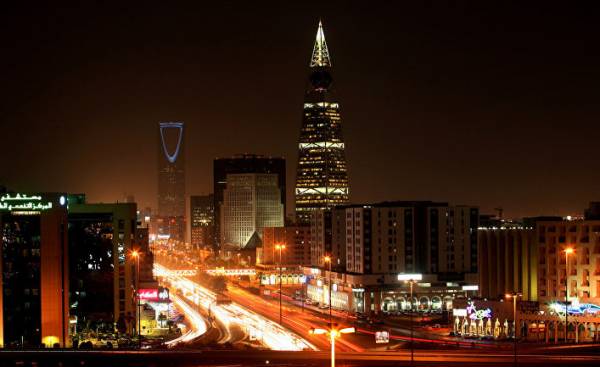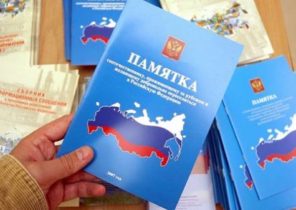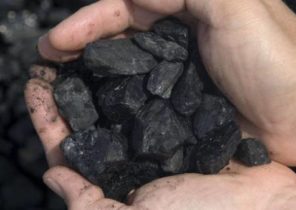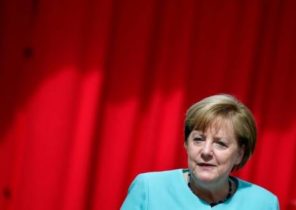
In his next report “prospects for the global economy”, published in early 2017, the international monetary Fund (IMF) significantly downgraded the forecast for GDP growth in Saudi Arabia to 2017: GDP growth of Saudi Arabia by the end of 2017 will amount to only 0.4%, whereas earlier, in October 2016, projected growth of 2%. In a new IMF report published in April, these figures have remained unchanged.
The main reason for such a dramatic lowering of the forecast is the expected fall in oil GDP by reducing oil production in line with what the IMF calls “the OPEC agreement,” which entered into force at the beginning of this year. The IMF is based on the premise that the agreement on the reduction of volumes of extraction will last throughout 2017. The expectation of some slowing of growth in non-oil sector has become a secondary reason for the lowering of the forecast.
In other words, the decline in oil production by about 5% slow down overall GDP growth by 80% (if compared to the previous forecast of 2% with the current forecast for 2017 0.4%). If we take as a basis for some less shocking comparison, we can conclude that the IMF believes that the slight decline in oil production will lead to the slowing down of GDP growth rate of Saudi Arabia 70% (if compared to growth in 2016, amounting to 1.4 percent, the new forecast for 2017 0.4%). However, both these comparisons draw almost equally gloomy picture. Meanwhile, the economy of Saudi Arabia is an extremely interesting puzzle, collect which follows very carefully.
Triangle petroleum: production, exports and revenues
According to the monthly OPEC report on the state of the oil markets, published on April 12, in the first two months of 2017 Saudi Arabia has reduced oil production on average 580 TB/d compared to average production volumes in 2016, which is about 5.5%. On the other hand, in the first quarter of 2017, prices on crude oil (Brent Dated) rose by almost 60% compared to the same period last year, indicating a very substantial income growth in Saudi Arabia in the first quarter of 2017. Many are accustomed to believe that the decrease in the production of a barrel reduces the value of exports in the same barrel.
Fortunately, the reality is somewhat different. Without going into the search for specific numbers, it’s safe to say that Saudi Arabia is moving away from wasteful and polluting to the direct combustion of oil in the production process of electricity and in other industries and makes a choice in favor of natural gas. This trend is evident and there is no doubt, especially since the second half of last year. Another very favorable side of this trend is the additional benefit that, by itself, the increase in gas production brings GDP.
We need to remember that oil is different. Saudi Arabia produces and exports five different varieties of crude oil. The price also varies from the highest for the ultra-light oil to the lowest in grade Arab Heavy. Thus, from an economic point of view, just be smarter to cut production of the cheapest and most unclaimed grades of oil. Aside from the price, any decline in production should result in loss of GDP, but the reduction of the production of the cheapest varieties of crude oil translate into increased efficiency of processes of production and sales, which in turn leads to increased profits across the industry.
Thus, the decline in oil production will not be able to provide this much harmful effects on the economies, making the sale of oil — not to mention the huge difference in prices, which was observed in the first quarter. Such competent production cuts can be a great opportunity to prepare the oil fields for future production cycles. However, plans for maintenance are still unclear, like whether to have a marked effect on the country’s GDP this year.
The rise of SABIC
In the past few years, Saudi Arabia began the rise of innovative industries, particularly in the area of petroleum products. SABIC is now one of the top lines in the list of the largest petrochemical companies in the world. It is also included in the list of the 100 largest corporations in the world according to Forbes and is the largest public company in the middle East. It is recognized that the establishment of SABIC in the mid 1970-ies, when oil was a kind of a rising star, was really successful and far-sighted decision. If in power there are people able to keep a clear mind, despite the constant desire to increase revenues from the sale of oil, it is a real blessing, no less valuable than the oil itself. As we will see below, the role of SABIC in the economy is steadily growing, and the role of innovative industries over time will also grow and will eventually become one of the main factors to be considered in the projections.
SABIC has been affected by the current cycle of decline in oil prices to a somewhat greater extent than its major competitors, simply because it receives domestic crude oil and gas at a subsidized price. In other words, the decline in oil prices has brought the production cost competitors to the cost of production from the company SABIC. Now, it is unclear at what price oil and gas are usually sold to SABIC. Nevertheless, many analysts suggest that prices are heavily subsidized. SABIC also benefits from a powerful oil infrastructure that exists in Saudi Arabia, and from the joint venture with Aramco projects, there is an indirect way of strong technical and financial base.
Despite the fact that in the case of Saudi Arabia’s revenues from oil exports is always very high, the combined income of SABIC compared to them was approximately 15%, and this is a very high figure. In 2015, the ratio of income SABIC and total income from oil exports reached 30%, indicating the growing influence of this company on the economy of the Kingdom. Such a sharp increase cannot be explained by the falling price of oil, because it is the fall caused by the SABIC is comparable in power strike.
A marked increase in oil prices in the first quarter of this year compared with the same period in 2016, gave a powerful impetus to SABIC, so this year she will likely derive a very significant benefit, becoming a countervailing factor against decrease of production volumes. In any case, now SABIC is too powerful and large, so we can ignore it in an attempt to draw the future of the economy of Saudi Arabia. We need to pay particular attention to its production plans and expansion projects in the short and long term.
The situation in the domestic market
Probably, readers rarely think about the fact that in the countries-exporters of oil there is a sector not associated in any way with the processes in the oil sector and public spending. Saudi Arabia is no exception. With this in mind, the so-called non-oil sector/non-oil GDP — in addition to its effects on GDP growth through its direct share in the national economy, can serve as a reliable indicator of the prevailing sentiment regarding economic policy and government spending in the short term.
Usually the main indicators are the shares of Emirates NBD and Saudi Arabia PMI index. Judging by these indicators, at the beginning of 2017 in the non-oil private sector has been a notable improvement (January, February and March). Analysis of the PMI showed a sharp increase in demand in non-oil sector in Saudi Arabia. In February 2015, this index reached its maximum since August, 2015. Analysis of changes of the index also showed that new orders grew at a tremendous rate for the last 14 months, which entails positive forecasts for the non-oil sector in the next couple of months.
Another indicator is inflation. Consumer prices in Saudi Arabia increased from 2.2% in 2015 to 3.5% in 2016 because of rising prices for electricity, gas and fuel, and water. It is to be expected consequences that show themselves a little differently next year. In other words, the shock of price adjustments has affected the economy in 2016, and now they are an integral part of the economy. Therefore, in the first three months of 2017, the rate of inflation declined slightly. We are not talking about quite the unnerving process of deflation, which is mentioned in unadapted literature. The decline in inflation was not due to falling demand, but rather high initial level of prices for some public goods. This should have a positive impact on the growth of domestic consumption in 2017.
One simple principle of national economic accounting can contribute to the refutation of the IMF. This year the rate of inflation can slow down. At least before the new round of price reform, the inflation rate may decline in the power of the original marks, as discussed above. Inflation may again begin to grow, although not as fast as last year, although this will depend on the extent of future reforms. If that happens, then the nominal non-oil GDP in 2017 could end up to test the impact of a lower deflator compared with the year 2016. This will lead to artificially inflated real GDP in this sector. Even if the GDP deflator will be in 2017 to increase, but at a slower speed compared with the year 2016, it will have a positive impact on the relative real GDP growth this year. This relative advantage will counterbalance the negative impact of a decrease in volumes of oil production, which the IMF considers a major factor in the slowdown in economic growth.
Signals from the authorities
The official position of the authorities is a Central aspect that is always taken into account by analysts, to build predictions for any economy in the world. Last year in a popular program on television in Saudi Arabia, a senior official from the Ministry of Finance tried to justify the need for lower public expenditure and higher prices for fuel, electricity and water. The terms that he used scare ordinary citizens. Although no one sought, but in the minds of the audience gained a very grim picture. Residents perceived these conversations negatively. Later this officer was fired and the Finance Minister was replaced. Some international publications considered it an attempt to get rid of people who are persons of austerity measures.
After less than two months was released the budget in 2017, according to which government spending in 2017 was increased by 8% compared to the previous year. This announcement was contrary to most market expectations, suggesting a reduction in state spending for the third consecutive year, after reduction by 12% and 15.5% in 2015 and 2016, respectively. These two changes were very significant and, apparently, related to each other, so analysts concerned with forecasts of GDP, we should not lose sight of him. The planned increase in public spending of 8% can easily neutralize the negative impact of the decline in oil production by about 5% on projected GDP in 2017.
In addition, recently, a few days after the publication of the April IMF report “prospects of development of world economy”, the authorities announced the return of the old scheme benefits for civil servants, which was abolished last year as part of the process of fiscal consolidation. Lower compared to previous forecasts the deficit in the first quarter of 2017 allowed the authorities to take this step.
It is expected that the next round of price adjustments for public goods in Saudi Arabia will come after mid-2017. After the introduction last year of measures that can be described as “low hanging fruits”, the next step will be quite difficult. The impression that the economic leadership of Saudi Arabia is well aware of how delicate must be the process. The government announced a new scheme under which all families whose income is medium or low will receive from the government the funds to offset their costs of providing basic needs. It is believed that families in Saudi Arabia will start to get this financial assistance before the start of price and tax reforms. Now the center of public sentiment has shifted from talking about raising the price to talk about the size of payments. While the situation looks like a negative impact on growth will be reduced if the authorities will exercise caution at all stages of the process.
In January 2017 the new Finance Minister of Saudi Arabia said in Davos that, according to his estimates, GDP growth will substantially exceed the forecasts of the IMF and will be more than 1%. He also said: “We have information that they have, this explains such differences in the forecasts”. In addition, according to news publications, in this year, Saudi Arabia will receive credits worth $ 15 billion, and it has already started to use the debt markets, receiving $ 9 billion as a result of sales of Islamic bonds. Last year the total sales of government bonds amounted to 17.5 billion dollars, which became the largest placement in the history, according to market sources.
It should be noted that in this analysis we have used the advantage of the availability of data for the first three months of 2017, while analysts, IMF had to settle for the data for December 2016. However, the key points of this analysis need further confirmation of specific figures for the current year. They are based on the basic economic principles concerning the officially published budget, replacement of oil for domestic consumption, exports of oil and the expected revenues from oil exports, the value of increasing natural gas production to GDP, increasing the role of the petrochemical industry, forecasts for inflation and the effect of the deflator, indicators of the nature of the future price and tax reforms.
It would not be reasonable to justify a radical change in your forecast to only one factor, since in the economy there are a lot of serious processes. The indicators of January and February only serve as confirmations of the main points of view concerning the private sector and inflation in Saudi Arabia. As the IMF has experienced undue influence of news that the media and the IMF called “the OPEC agreement,” he may need to revise its forecast for Saudi Arabia and to increase it to 1%. The economy of Saudi Arabia is quite capable in 2017 to achieve GDP growth of 2.2% in the case of events in the most favorable scenario, and growth of 1.3% is quite a realistic goal.
It is extremely important not to simplify the program “the Vision of the Kingdom of Saudi Arabia 2030” and not to take her to the elimination of subsidies and budget cuts. Significant investment in infrastructure is a necessary condition for the success of any section of this plan. In fact, if the economy will enter a period of stagnation, as predicted by the IMF, it will only be a hindrance towards the realization of “Vision 2030”. Rapid population growth combined with political challenges and security issues in the middle East prevent to imagine the possibility of economic stagnation.
Signals coming from November of last year, indicate that the economic leadership of the country understands the necessity of the stated transformation, but also the need for sensitive and thoughtful approach to the implementation of the plans without any significant shocks. At this stage it is essential to establish the true credibility of the economic policy of the Kingdom and to be as predictable for the market. It only requires a thoughtful approach. This is the only way to avoid sharp turns in the reform process, and mixed and confusing signals which will significantly complicate the implementation process and increase the risk of failure. Time will tell what the final result of real interaction of economic variables.







